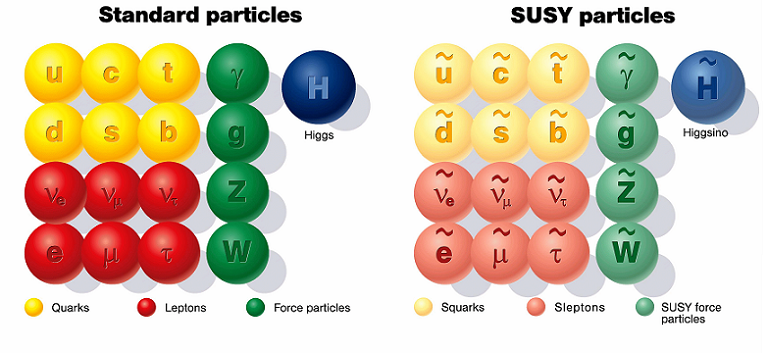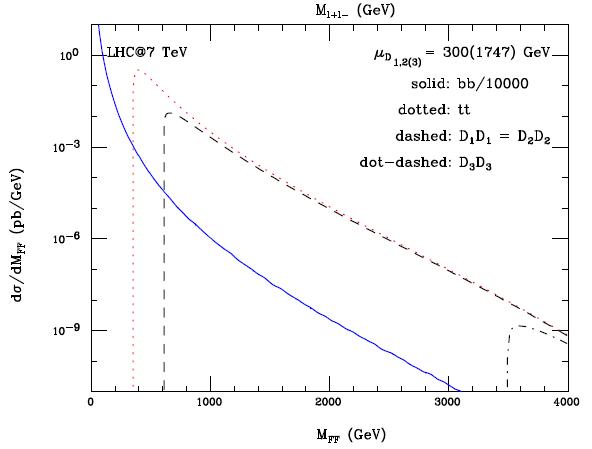Physics Beyond the Standard Model?
Since the development of the Standard Model (SM) of particle physics in the late 1960's and early 1970's, it has been clear that the SM cannot be the ultimate theory of elementary particles (not to mention the theory of everything). There are already observations (e.g. dark matter) and theoretical arguments (e.g. related to quantum gravity) that prove the existence of physics beyond the SM. However, we must ask: what is this physics beyond the SM, and how can we observe and study it at dedicated elementary particle experiments? Research of the last three decades has indicated that physics beyond the SM should appear in experiments at the energy scale currently being probed by colliders, in particular the Large Hadron Collider (LHC) currently running at CERN. Very exciting times in particle physics are ahead of us. Answers to fundamental questions can be expected, and physics beyond the SM, in particular supersymmetry, might be directly observed.
Supersymmetry
Supersymmetry is one of the most intriguing and fundamental concepts in modern theoretical particle physics. It arises naturally from the combination of the two cornerstones of 20th century physics: quantum mechanics and relativity. Supersymmetry is the unique symmetry that relates the two fundamental kinds of particles: bosons, which act as the carriers of forces, and fermions, which act as the constituents of matter. Supersymmetry transformations are in a sense like the square roots of the coordinate system transformations in special relativity, and consequently supersymmetric quantum field theories have very special, improved properties, compared to ordinary relativistic quantum field theories. If supersymmetry is realized in nature, every fermion in the SM must have a bosonic partner particle and vice versa. No such superpartner particle has been observed so far but there are more and more indications that these particles might show up at the LHC experiments.

Research in Glasgow
The startup of the LHC in 2009 marks the beginning of a new era in particle physics. For the first time it will is possible to directly examine physics at the TeV scale, many fundamental questions can be answered and - if they exist - supersymmetric particles can be directly produced. A prime task in the quest to understand physics at the TeV scale is to discover and identify these supersymmetric particles. In Glasgow we have developed strategies for these measurements, using, for example, cascade decays where one heavy supersymmetric particle (such as a squark) decays via several intermediate steps into many SM particles and one light supersymmetric particle.
The pattern of supersymmetric particle masses can give us clues on much deeper questions such as the grand unification of all forces or the origin of the three families of particles. At Glasgow we are also studying models of Grand Unification to predict their low energy mass spectrum and the associated phenomenology at the LHC. Of particular interest are the unification groups SU(5), SO(10) and E6. E6 is large enough to contain all the (non-force-mediating) particles in a single multiplet, including the Higgs bosons and a right handed neutralino. It is also a natural group to emerge from String Theory, possibly as a remnant of the larger group E8. Models based on E6 have a very rich phenomenology at the LHC, and predict extra particle states including a Z' and exotic quarks. Since the exotic quarks are strongly interacting, they can have very large production cross-sections at the LHC, so their discovery could be just around the corner.

Production cross-sections for exotic quarks (labelled D) at the LHC, showing a very sizable production rate.
References
- Supersymmetric SU(5) Grand Unification for a Post Higgs Boson Era; D.J. Miller and A.P. Morais; arXiv:1307.1373; Abstract, PDF, Citations.
- Constraining Grand Unification using first and second generation sfermions; D.J. Miller, A.P. Morais, and P.N. Pandita; Phys. Rev. D 87, 015007 (2013); arXiv:1208.5906; Abstract, PDF, Citations.
- Constrained Exceptional Supersymmetric Standard Model with a Higgs Near 125 GeV; P. Athron, S.F. King, D.J. Miller, S. Moretti, and R. Nevzorov; Phys. Rev. D 86, 095003 (2012); arXiv:1206.5028; Abstract, PDF, Citations.
- LHC Signatures of the Constrained Exceptional Supersymmetric Standard Model; P. Athron, S.F. King, D.J. Miller, S. Moretti, and R. Nevzorov; Phys. Rev. D 84, 055006 (2011); arXiv:1102.4363; Abstract, PDF, Citations.
- The Constrained Exceptional Supersymmetric Standard Model; P. Athron, S.F. King, D.J. Miller, S. Moretti, and R. Nevzorov; Phys. Rev. D80 (2009) 035009; arXiv:0904.2169; Abstract, PDF, Citations.
- Predictions of the Constrained Exceptional Supersymmetric Standard Model; P. Athron, S.F. King, D.J. Miller, S. Moretti, and R. Nevzorov; Phys. Lett. B681 (2009) 448-456; arXiv:0901.1192; Abstract, PDF, Citations.
- Leptogenesis in the Exceptional Supersymmetric Standard Model: flavour dependent lepton asymmetries; S.F. King, R. Luo, D.J. Miller, and R. Nevrozov; JHEP 0812 (2008) 042; arXiv:0806.0330; Abstract, PDF, Citations.
- Invariant mass distributions in cascade decays; D.J. Miller, P. Osland, and A.R. Raklev; JHEP 0603 (2006) 034; hep-ph/0510356; Abstract, PDF, Citations.
- Measurement of the Gluino Mass via Cascade Decays for SPS 1a; B. K. Gjelsten, D. J. Miller, and P. Osland; JHEP 0506 (2005) 015; hep-ph/0501033; Abstract, PDF, Citations.
- Measurement of SUSY masses via cascade decays for SPS 1a; B. K. Gjelsten, D. J. Miller, and P. Osland; JHEP 0412 (2004) 003; ATL-PHYS-2004-029; hep-ph/0410303; Abstract, PDF, Citations.

